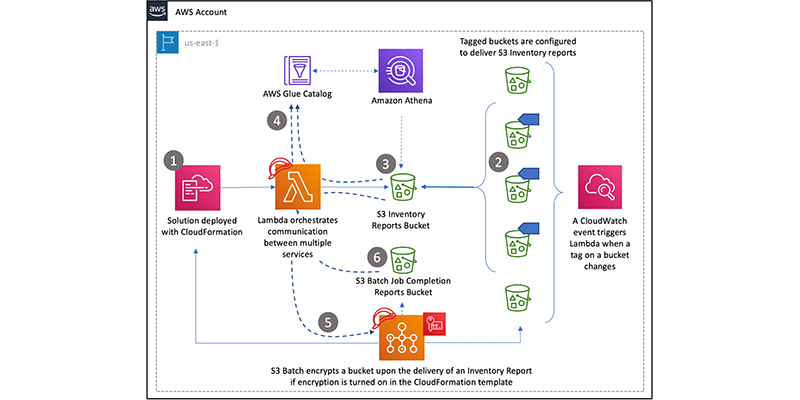AWS Security Blog
Category: Analytics
Automatically updating AWS WAF Rule in real time using Amazon EventBridge
December 4, 2020: This post has been updated to include links to the CloudFormation templates used in the solution. In this post, I demonstrate a method for collecting and sharing threat intelligence between Amazon Web Services (AWS) accounts by using AWS WAF, Amazon Kinesis Data Analytics, and Amazon EventBridge. AWS WAF helps protect against common […]
Automate Amazon Athena queries for PCI DSS log review using AWS Lambda
In this post, I will show you how to use AWS Lambda to automate PCI DSS (v3.2.1) evidence generation, and daily log review to assist with your ongoing PCI DSS activities. We will specifically be looking at AWS CloudTrail Logs stored centrally in Amazon Simple Storage Service (Amazon S3) (which is also a Well-Architected Security […]
How to retroactively encrypt existing objects in Amazon S3 using S3 Inventory, Amazon Athena, and S3 Batch Operations
November 1, 2021: AWS KMS is replacing the term customer master key (CMK) with AWS KMS key and KMS key. The concept has not changed. To prevent breaking changes, AWS KMS is keeping some variations of this term. More info. Amazon Simple Storage Service (S3) is an object storage service that offers industry-leading scalability, performance, […]
How to analyze AWS WAF logs using Amazon Elasticsearch Service
September 9, 2021: Amazon Elasticsearch Service has been renamed to Amazon OpenSearch Service. See details. Log analysis is essential for understanding the effectiveness of any security solution. It can be valuable for day-to-day troubleshooting and also for your long-term understanding of how your security environment is performing. AWS WAF is a web application firewall that […]
How to Visualize and Refine Your Network’s Security by Adding Security Group IDs to Your VPC Flow Logs
September 9, 2021: Amazon Elasticsearch Service has been renamed to Amazon OpenSearch Service. See details. August 31, 2020: The directions in this blog post for how to create an Amazon ES cluster have been updated. February 28, 2019: The features and services described in this post have changed since the post was published and the […]
Amazon QuickSight Now Supports Audit Logging with AWS CloudTrail
Amazon QuickSight democratizes business intelligence, making it easier and cheaper for you to provide advanced business analytics capabilities to everyone in your organization. Amazon QuickSight also enables you to understand your business better and helps you make data-driven decisions more quickly. However, determining who has access to which data in your organization can still be […]
How to Control Access to Your Amazon Elasticsearch Service Domain
September 9, 2021: Amazon Elasticsearch Service has been renamed to Amazon OpenSearch Service. See details. With the recent release of Amazon Elasticsearch Service (Amazon ES), you now can build applications without setting up and maintaining your own search cluster on Amazon EC2. One of the key benefits of using Amazon ES is that you can […]
Amazon Redshift and Amazon RDS Now Support Encryption via AWS Key Management Service in the AWS GovCloud (US) Region
Today, Amazon Redshift and Amazon RDS for MySQL, PostgreSQL, Oracle, and SQL Server DB released support for encryption using AWS Key Management Service (KMS) in the AWS GovCloud (US) region. Using keys under your control, you can now encrypt RDS instances, including MySQL, PostgreSQL, Oracle, and SQL Server DB instance types, and Amazon Redshift clusters in AWS GovCloud […]
Amazon CloudSearch: Now with More Granular Access Control for Domains
Yesterday, Amazon CloudSearch released a new version that is fully integrated with AWS Identity and Access management (IAM) and enables you to control access to a domain’s document and search services. Jon Handler, an AWS Solution Architect who specializes in search, describes the new features. In March, we released a new Amazon CloudSearch API that […]
New in Amazon EMR: Support for Federated Users
AWS announced yesterday that Amazon Elastic MapReduce (EMR) added support for federated users. If you use Amazon EMR, you can now enable users to administer Amazon EMR clusters who are signed in to your corporate network using their corporate credentials—you no longer need to create IAM users for access to EMR. Up to now, federated […]







